#Roman costume
Text




Roman Brooch Pins, Lancaster City Museum, Lancaster
#Roman#roman brooch#romans#roman city#roman army#Lancaster#roman trade#roman britain#roman empire#roman jewellery#roman costume#archaeology#ancient living#ancient crafts#metalwork#trumpet brooch#ancient cultures
24 notes
·
View notes
Photo

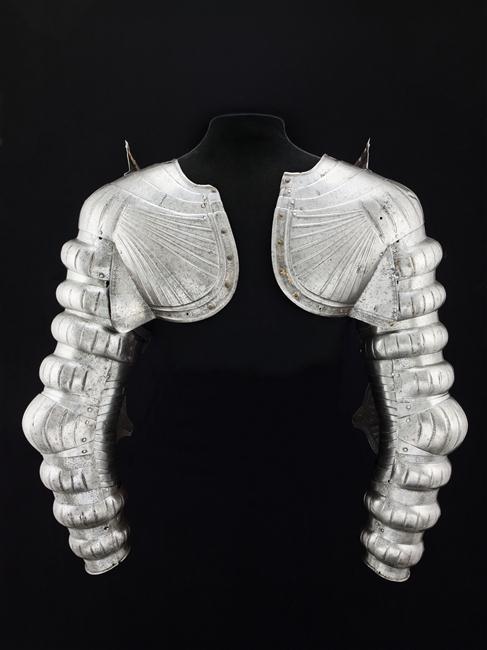
A pair of elaborate puffed and slashed Arm Harnesses, Germany, ca. 1520, housed at the Musée de l'Armée.
#armor#armour#costume armor#puffed and slashed#europe#european#germany#german#hre#holy roman empire#renaissance#musee de l'armee#art#history
2K notes
·
View notes
Text

Thomas Couture (1815-1879)
"The Romans in their Decadence" (1847)
Oil on canvas
Located in the Musée d'Orsay, Paris, France
#paintings#art#artwork#history painting#ancient rome#thomas couture#oil on canvas#fine art#musee d'orsay#museum#art gallery#french artist#ancient romans#decadence#decadent#indulgence#costume#costumes#1840s#mid 1800s#mid 19th century#aesthetic#aesthetics
233 notes
·
View notes
Text
Wait-

WAIT

OMFG ROMAN


#nevermind what I said about him being nice this is terrible#😂😂😂😂#regifting is an art and Roman clearly hasn’t learned it lol#costume recycling#clearly probably not intended to be a prop that looks like it was regifted but it’s funnier that it is#thomas sanders#sanders sides#roman sanders#Janus sanders#what makes the perfect gift#that’s my jam#ts details
203 notes
·
View notes
Text

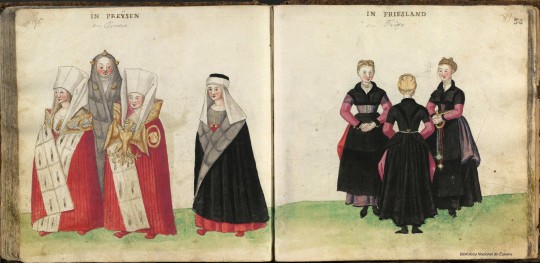


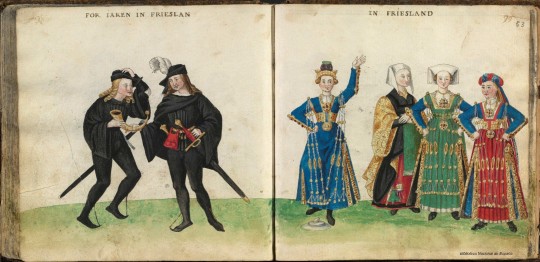

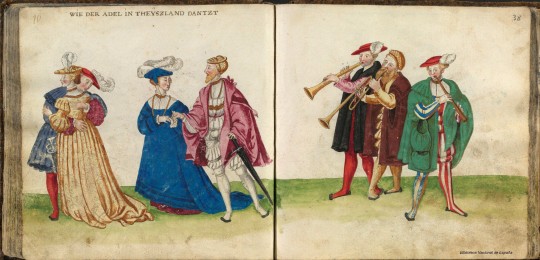
Códice de Trajes, costumes from the realms of Charles V, Holy Roman Emperor and King of Spain, made in Germany in mid 16th century (1540s-1550s)
Prussia
Prussia and Friesland
Schwabia and Elzach
Juelich
Frisia
Germany
German dance
#germany#manuscript#16th century#mdpillustration#illustration#costume illustration#1540s#1550s#holy roman empire#16th c. holy roman empire#prussia#mid 16th century
421 notes
·
View notes
Text
the black t shirt you can sometimes see peeking out from under Roman’s tunic was stolen from Virgil send tweet
#sanders sides#roman sanders#virgil sanders#prinxiety#ok I know there is more than likely a real world costuming explanation here but this is more fun
103 notes
·
View notes
Text
logan: i do not understand theatre, i think it's a waste of time. i don't get why anyone would be invested in playing a role on a stage.
also logan:

#earlier episodes of sanders sides my beloved#i can't tell if he was breaking character (as sherlock) here or if he was way too into it#the way he immediately summoned a costume and started roleplaying sherlock#sure logan you don't understand theatre#such a dork lol#sanders sides#logan sanders#thomas sanders#sasi#tss#logan ts#ts logan#ts logan sanders#tss logan#roman sanders#virgil sanders#remus sanders#patton sanders#remus tss
156 notes
·
View notes
Text

it’s something that can be so personal
#succession#succession hbo#suck session#hbo series#waystar royco#logan roy#kendall roy#roman roy#shiv roy#roy siblings#roy family#family dynamics#character analysis#parallels#film parallels#tv shows#costume design#color theory#symbolism
3K notes
·
View notes
Text
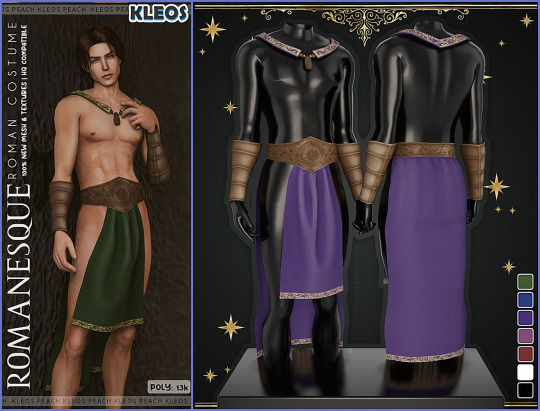

☾ ☆ DOWNLOAD FREE HERE ☆ ☽
★ NEW FEMALE ITEMS ★ | ★ NEW MALE ITEMS ★
#thesims#thesims4#sims#simscc#smsims#sims4downloads#sims4alphacc#sims4patreon#ts4#ts4downloads#sims4clothes#simstagram#sims4lookbook#smsimscc#sims 4 kleos#sims 4 costume#sims 4 roman
205 notes
·
View notes
Text

Endlessly entertained by ghosts being half in half out of costume
#rebecca in her normal clothing but with Hetty hair is so special to me#pete minus arrow and glasses#correct me if I’m wrong but is that like the underneath of Thor’s costume?#like the furs and stuff go on top or ?#ghosts us#cbs ghosts#this is like a screenshot from a video I found whilst stalking Roman’s Instagram I think
144 notes
·
View notes
Text



mild suggestive humor ↓
.
.
.
.
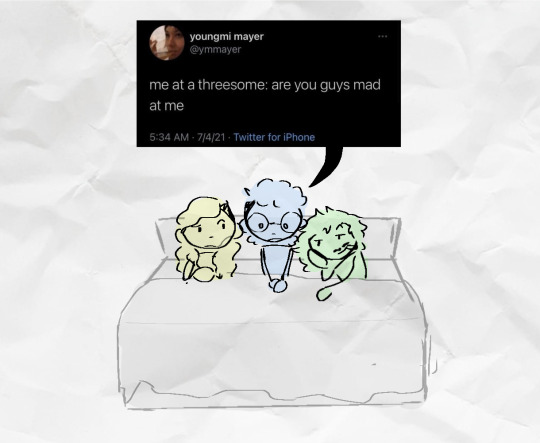

.
.
.
.
more funnies.... i cant be stopped
#mildly suggestive#very glad ppl seem 2 be enjoying these#they r a lot of fun for me to make#also!! i think ive finally found a patton design i like#which is good#experimented w virgils hair also and i like it but idk if ill ever remember 2 do it again#also im sure some1 out there is wondering why i draw every1 in their canon outfits EXCEPT for remus#and the answer is that i have personal beef with his outfit#and absolutely refuse to draw it !#its a great costume i think its designed very well i just hate drawing it#+ im mad its so complicated which means i will probably never get to cosplay him#intruality#dlampr#<- only IMPLIED technically. but it was fully my intention#intrumociet#<- is that the ship name for them?!?! fuck if i know#dukeciet#mociet#sanders sides#sasi art#remus sanders#janus sanders#patton sanders#logan sanders#virgil sanders#no roman this time... i really dont have a good grasp on him as a character so its harder 4 me to find posts that remind me of him#tss#ts sides#sanders sides art#my art
121 notes
·
View notes
Text
Steel Brocade: Puffed & Slashed Costume Armor
Surviving to this day in the collections of the world’s most illustrious museums are a group of three armors. These armors have much in common, but most striking is the attempts made by their armorers to render in steel a convincing portrayal of the puffed and slashed clothing fashionable to the early 16th century.
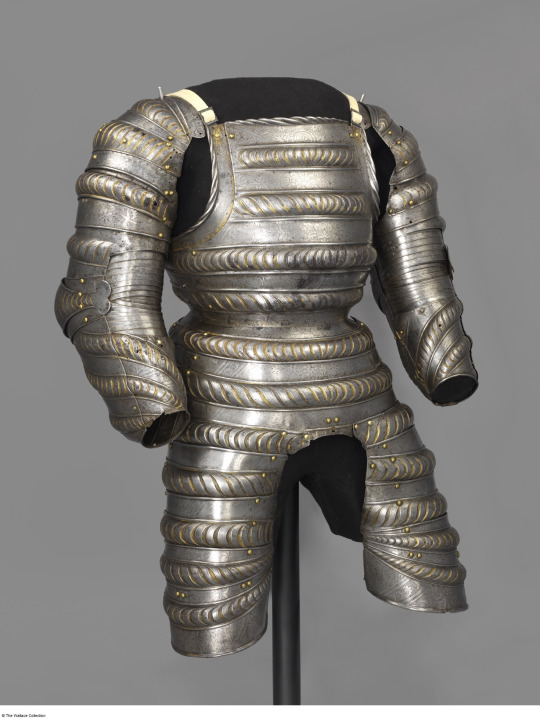


Though this fashion is synonymous with the landsknecht mercenaries who may have been responsible for popularizing it, the puffed and slashed style was enjoyed by members at all levels of society.

Portrait of Duke Henry of Saxony by Lucas Cranach the Elder, 1514, Staatliche Kunstsammlungen, Dresden.
The earliest of these three armors is housed at the Wallace Collection. Consisting only of a cuirass and arms, this armor is, at first glance, rather underwhelming when compared with the other armors in this group. Though the embossed bands styled with etched slashes embellished with gold provide the impression of a puffed and slashed doublet, the execution is all rather stiff, and lacks the impressive volume and fullness exemplified by the other armors.

It is for this reason that this armor, previously considered contemporary to the KHM and Metropolitan examples, has received relatively little attention. However, recent scholarship by Dr. Tobias Capwell suggests that this work is not, indeed, contemporary to the other examples, and is rather about ten years older, dating to ca. 1515. Dr. Capwell also considers this piece to be the work of Konrad Seusenhofer, a favored armorer of the Emperor Maximilian I.
Seen through this lens, not as a poorly executed contemporary of greater armors, but as a less developed ancestor to them, this armor takes on new life. It speaks to innovation and experimentation; an early attempt at a technique which would later be perfected.
The second in this line is the garniture of Wilhelm von Rogendorf, housed at the Kunsthistorisches Museum in Vienna.

This armor is unique for its condition, which is remarkably good. Not only does this armor retain more of its pieces than the other two, it is also accompanied by a number of “pieces of exchange,” elements which could be swapped out so the armor could be worn in the field.
Finished in 1523, as attested to by the date etched on the right shoulder strap, this armor was made for the Count Wilhelm von Rogendorf by Kolman Helmschmid and etched by Daniel Hopfer.

Wilhelm von Rogendorf himself was heir to a new, up-and-coming German noble family.

A medal showing Wilhelm von Rogendorf as a Knight of the Order of Calavatra, dated 1536, Kunsthistorisches Museum, Vienna.
Born in 1481 the second son of Kaspar von Rogendorf, Wilhelm became heir to his family’s estates when his elder brother Sigmund died in 1507, by which time Wilhelm was already a courtier at the Habsburg court. He entered into the service of King Charles I of Spain (later Emperor Charles V) no later than 1517 and was appointed Governor of Friesland. In 1522, Wilhelm accompanied Charles to Spain where he commanded a regiment of 4,000 landsknechts and was again placed in charge of a restless border territory. In 1524, he successfully captured the Fortress of Fuenterrabía from the French, which won him great praise from the Emperor. Shortly thereafter, Wilhelm was named Captain of the Imperial Bodyguard and given the governorships of Catalonia, the Cerdagne, and the Roussillon. Additionally, he was appointed to the Spanish chivalric Order of Calavatra. Wilhelm would retire from court in 1539, but would be recalled in 1541 to command Imperial troops against the Ottomans in Hungary. He would be killed later that same year at the siege of Buda by a stray cannonball.
Though Wilhelm’s armor is now displayed in its parade configuration, the surviving pieces of exchange attest to the fact that it was also an armor for combat. The cuirass is equipped with the long tassets common to the early 16th century. A pair of holes can be observed at the top of the last lame.

These holes correspond to holes at the top of the half-cuisses which accompany this armor, showing that these cuisses would be pointed to the tassets rather than worn separately.

In the rear, the cuirass is accompanied by a rump-defense, also known as a hoguine. Small turning pins near the waist allow this to be removed for combat.
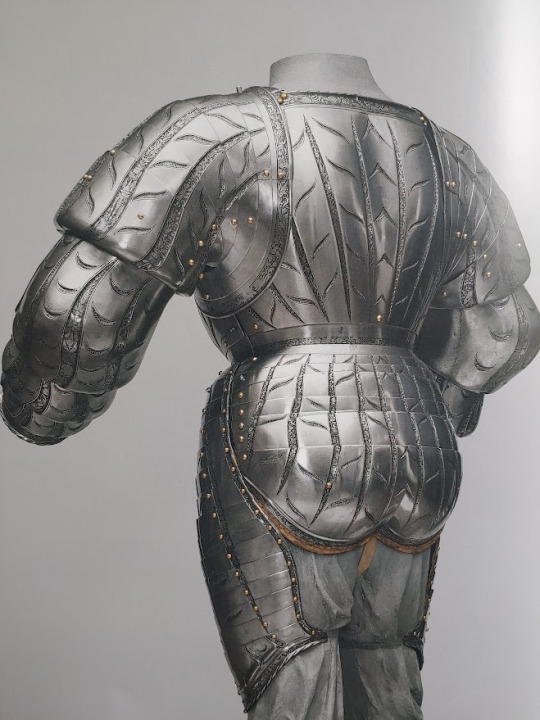
Both spaulders
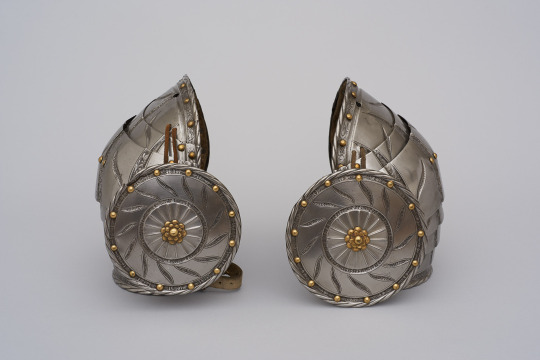
and gauntlets

survive. Additionally, the KHM retains the armor’s right vambrace

while the Wallace Collection holds the rerebrace and couter for the left arm.
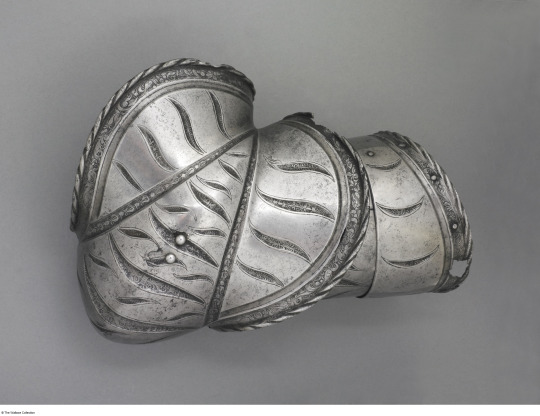
Recently, these pieces were assembled to show what the arm harness for field as a single unit would have looked like.
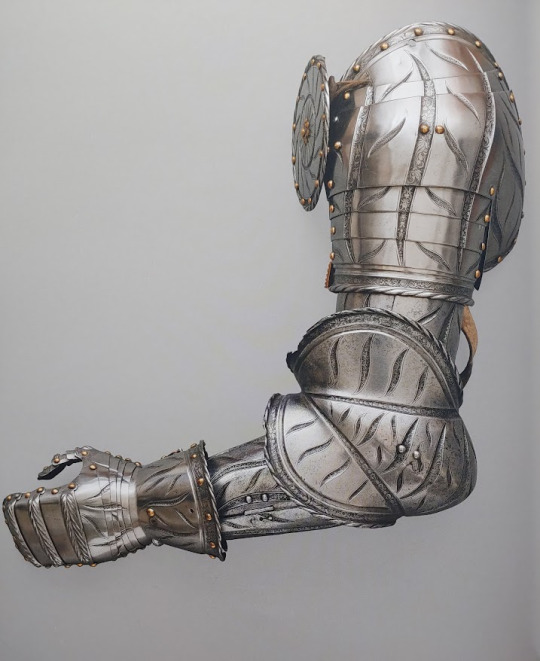
This armor would also have been accompanied by a gorget, now missing, and a helmet. Frequently, this armor is displayed alongside a close-helmet, however it is more likely the armor would have been accompanied by a burgonet similar in form to this example from the KHM.
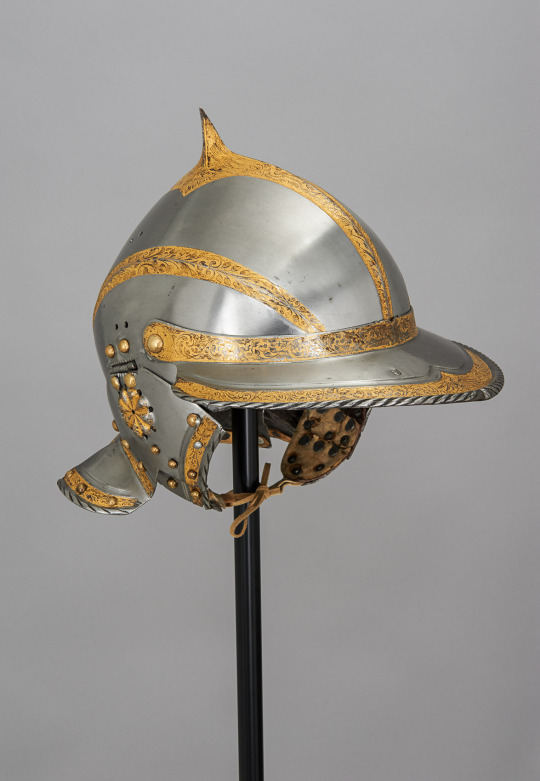
One final, unique surprise this armor holds is a hidden lance rest which is incorporated into the turned edge by the right arm. This rest folds down to allow a light lance to be braced atop it, and when folded up, is nearly invisible so as to not ruin the smooth surface of the breastplate with the prominent staples typically required for affixing a lance rest.

The third and final armor of this group is housed at the Metropolitan Museum of Art in New York City.

The least complete of these three armors, it may also be the most visually impressive. Comprised of only a backplate, hoguine, and arms, the puffs and slashes of this piece (also by Kolman Helmschmid and Daniel Hopfer) are ornately cusped. The slashed regions, displaying the gilded “fabric” beneath, and heavily etched to resemble an expensive silk brocade.
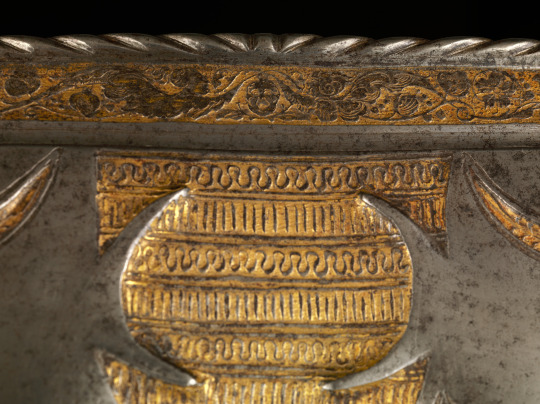
The sleeves of this armor are even more voluminous than those of the Rogendorf armor, though they are similarly articulated and provide the wearer with a surprising degree of mobility. It is thought that this armor may have been made for prominent Polish nobleman Jerzy Herkules Radziwill.
Interestingly, the hoguine of this armor is composed of two separate plates, rather than a single solid plate. Where the hoguine of the other two armors terminates in a decorative fabric border, the Met armor continues into two more articulated lames, covering the top rear of the thighs. Holes along the bottom edge suggest that this armor may have been accompanied by fully enclosing cuisses which pointed to the bottom of the fauld and hoguine.

Sources
“A Pair of Gauntlets.” Kunsthistorisches Museum Wien. https://www.khm.at/de/object/540164/.
“A Pair of Spaulders with Besagews.” Kunsthistorisches Museum Wien. https://www.khm.at/de/object/372772/.
Cranach, Lucas the Elder. “Portrait of Duke Henry of Saxony.” Staatliche Kunstsammlungen Dresden. https://skd-online-collection.skd.museum/Details/Index/246875.
Krause, Stefan. Fashion in Steel. Vienna: Kunsthistorisches Museum, 2017.
“Landsknecht Costume Armour.” Kunsthistorisches Museum Wien. https://www.khm.at/de/object/372771/.
“Left Upper Cannon and Couter.” The Wallace Collection. https://wallacelive.wallacecollection.org:443/eMP/eMuseumPlus?service=ExternalInterface&module=collection&objectId=60736&viewType=detailView.
“Open Burgonet.” Kunsthistorisches Museum Wien. https://www.khm.at/en/object/503346/.
“Parts of an Armour.” The Wallace Collection. https://wallacelive.wallacecollection.org:443/eMP/eMuseumPlus?service=ExternalInterface&module=collection&objectId=60519&viewType=detailView.
“Portions of a Costume Armor.” The Metropolitan Museum of Art. https://www.metmuseum.org/art/collection/search/27790.
“Vambrace.” Kunsthistorisches Museum Wien. https://www.khm.at/de/object/372773/.
“Wilhelm von Rogendorf.” Kunsthistorisches Museum Wien. https://www.khm.at/de/object/1409642/
.
#long post#armor#armour#landsknecht#costume armor#art#history#renaissance#germany#german#hre#holy roman empire#europe#european#themet#metmuseum#khm#skd#wallace collection
1K notes
·
View notes
Text

Rembrandt (1606-1669)
"Lucretia" (1644)
Oil on canvas
Dutch Golden Age
Located in the Minneapolis Institute of Art, Minneapolis, Minnesota, United States
#paintings#art#artwork#history painting#ancient rome#rembrandt#oil on canvas#fine art#dutch golden age#baroque#minneapolis institute of art#museum#art gallery#dutch artist#female portrait#portrait of a woman#roman history#costume#costumes#pain#agony#despair#rage#tw blood#1640s#mid 1600s#mid 17th century
100 notes
·
View notes
Photo




SCREAM 3
(2000) dir. Wes Craven
#filmedit#horroredit#screamedit#dailyflicks#scream franchise#scream 3#moviegifs#filmgifs#filmtv#horrorgifs#roman is sidney's foil and represents the resentment she has for her mom for putting her in these situations and killing him was her way#of letting go of that toxic feeling#anyway roman is my fav killer and he gets paid dust by the fans and the franchise#billy's costume shouldn't have been in the glass case in the 6th it should've been romans since he started it!!!!!!#end rant
837 notes
·
View notes
Text
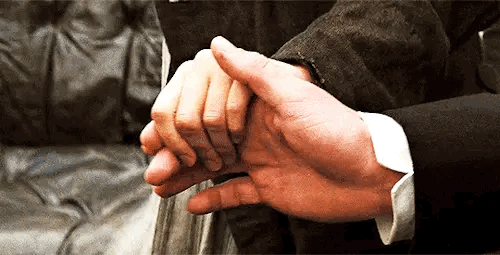

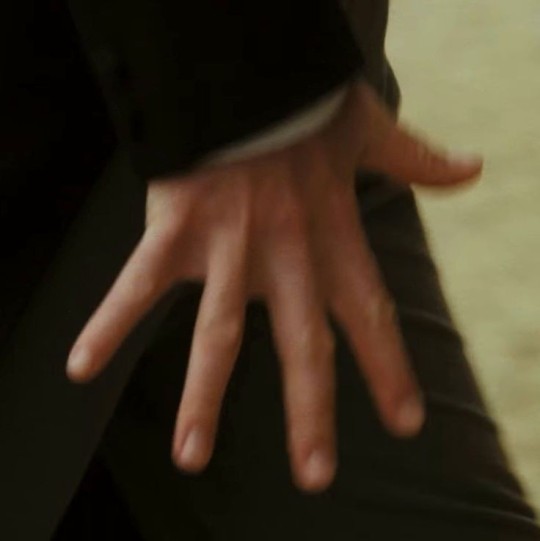
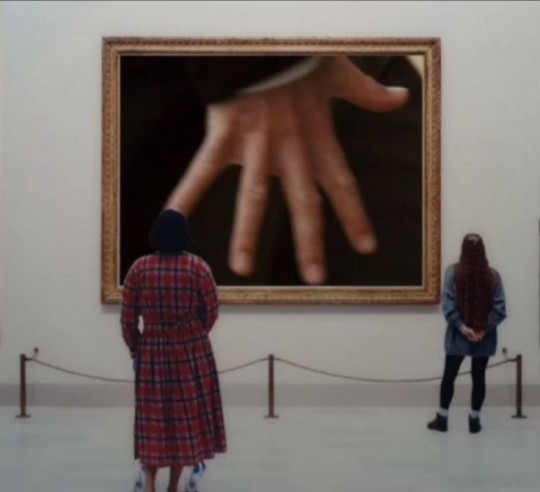

#pride and prejudice#pride and predjudice 2005#mr darcy#elizabeth bennet#jane austen#my roman empire#girlblogging#quotes of movies#im just a girl#costume drama#period drama#keira knightley#letterboxd#aesthetic#girl things#matthew macfadyen
145 notes
·
View notes
Text
I can’t stop thinking about Remus representing jealousy and envy, in the same way Roman isn’t just creativity, he’s also ego, pride, and passion. It always felt a little lopsided to me that they were halves a whole, and yet Roman has all this extra stuff. But what if Remus has some extra stuff of his own, things that mirror Roman’s extra stuff.
Consider the feeling you get when you work very hard on something creative, something you’re proud of, only for your work to be passed over for someone else. Consider the envy you might feel when someone else succeeds in the same area you wish you could. Even when it’s a friend, someone you care about, that feeling creeps up sometimes. Don’t you deserve the recognition just as much as they do, if not more? Or maybe, they made something better than you, and you wish it was yours. Either way, that’s envy. Wanting something someone else has.
Alternatively, consider jealousy, in a romantic sense. The moments when your partner seems to click with someone else, or someone flirts with them, or they’re just plain spending more time with other people than you. It happens, it’s normal. But you can’t help that niggling sense of jealousy in the back of your mind, fueled by insecurity and fear of losing the one you love, that some might take what’s yours away from you. Maybe you imagine in great detail what they’re doing right now, or any number of scenarios in which they leave you or cheat on you. You know you’re being irrational, but even so it’s hard to put those thoughts to rest.
In both cases, these aren’t wanted feelings, but they’re there anyway, a lot like intrusive thoughts (and in fact in some situations they can be a form of intrusive thought!), and they’re also both extensions of things that Roman represents. Envy and jealousy are both forms of desire tempered with ego and insecurity.
So, where Roman is pride in your work, and desire and passion for your partner, and Remus is wondering why someone else got rewarded for their work and you didn't, and the fear someone will take away the one you love.
In other words, Remus makes you green with envy.
#Sanders Sides#Sanders Sides meta#Remus Sanders#Roman Sanders#creativitwins#this literally started because I thought 'hey green is the color of envy and jealous that's interesting'#also I hope it is clear that I know envy and jealous are two different things from how I described them#cause I do know#but there's “green with envy” and there's “the green eyed monster” for jealousy#both applicable#and they're closely related terms#and it just made sense to put them together for this#I hope this makes sense!#intelligence is knowing that Roman is red because that's the costume thomas happened to have when he started this#and Remus is green because that's the opposite of red#wisdom is knowing that Roman's red is representative of passion and love regardless now and that Remus's green can be representative#or more than just “the opposite of Roman”
59 notes
·
View notes